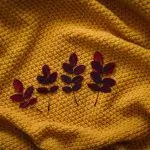Imagine dyeing a sheet is like painting a canvas, each brushstroke adding a unique hue to create a masterpiece.
But how does one transform a plain sheet into a vibrant work of art?
Let's unravel the secrets of turning a simple fabric into a colorful wonderland.
Exploring techniques and tips that will elevate your bedding to a new level of sophistication and style.
Table of Contents
Key Takeaways
- Consider fabric type for appropriate dye selection
- Follow precise dye mixing guidelines for desired colors
- Apply dye evenly to prevent streaks and ensure quality
- Rinse with cold water and dry carefully for vibrant results
Choosing the Right Dye
When dyeing a sheet, I always make sure to choose the right dye that will provide vibrant and long-lasting color. Color selection plays an important role in achieving the desired outcome. It's vital to take into account the fabric type and the specific dye techniques that will work best for the material.
Fabric compatibility is key when selecting a dye. Different fabrics react differently to various dyes, so it's important to pick a dye that's suitable for the specific fabric of the sheet. Cotton, for example, may require a different type of dye compared to silk or polyester. Understanding the fabric's composition is necessary for a successful dyeing process.
Dye application is another critical aspect to take into account. The way the dye is applied can affect the final result significantly. Whether you choose to dip-dye, tie-dye, or use a different technique, it's important to follow the instructions carefully to ensure even color distribution and long-lasting vibrancy. Proper dye application techniques can make a substantial difference in the overall quality of the dyed sheet.
Preparing the Sheet
To prepare the sheet for dyeing, start by thoroughly washing it to eliminate any dirt or residues that could impact the dyeing process. Here are some key steps to make sure your sheet is ready for the dye:
- Color Selection: Choose the dye color you desire and guarantee it complements the fabric of the sheet. Consider the color wheel to understand how different colors interact.
- Fabric Preparation: Check the fabric content of the sheet to determine the appropriate dye type. Natural fibers like cotton may require different preparation compared to synthetics.
- Temperature Control: When washing the sheet, use the recommended water temperature to ensure effective removal of dirt and residues without damaging the fabric. Follow the care instructions provided by the manufacturer.
- Dye Application Techniques: Familiarize yourself with different dyeing techniques such as immersion dyeing or tie-dyeing. Select the method that aligns with the design you wish to achieve on the sheet.
Setting up Your Workspace
Setting up my workspace for dyeing the sheet involves organizing all the necessary materials and ensuring a clean and well-ventilated area for the dyeing process. When considering workspace organization, it's important to lay out the sheet flat on a covered surface to avoid any spills or stains. Selecting the colors you wish to use is an exciting part of the process, so have your chosen dyes readily accessible. Tools placement is essential; make sure your dye bottles, brushes, gloves, and any other equipment you need are within easy reach to streamline the dyeing process.
To set the stage for successful dyeing techniques, make sure the area is well-lit to accurately gauge color intensity and coverage. Additionally, having a nearby water source for rinsing and cleaning tools can be immensely helpful. By meticulously arranging your workspace, you'll create an environment conducive to creativity and precision when dyeing your sheet.
Mixing the Dye Solution
I'll walk you through the important steps of mixing the dye solution – gathering all the necessary materials, ensuring you prepare the dye according to instructions, and prioritizing safety precautions.
Let's start by getting everything we need ready, then we'll carefully follow the dye preparation guidelines, and always keeping safety in mind throughout the process.
It's vital to stay focused and handle the dye solution with care to achieve the best results while staying safe.
Gather Necessary Materials
When preparing to dye a sheet, the first step is gathering all the necessary materials for mixing the dye solution. Here are the key items needed:
- Fabric preparation tools: This includes items like a wash basin, detergent, and gloves for ensuring the sheet is clean and ready to receive the dye.
- Dye selection: Choose the dye colors you desire for your sheet. Make sure you have the appropriate quantity and color mixing chart if needed.
- Measuring tools: Have measuring spoons or cups to accurately mix the dye and water in the right proportions.
- Mixing containers: Prepare containers to mix the dye solution. It's advisable to use containers that are easy to clean after use.
Prepare Dye According
To prepare the dye solution, gather the dye colors you selected, measuring tools, and mixing containers in a well-lit workspace. When mixing dyes, precision is essential for achieving the desired color intensity. Here is a simple table to guide you in mixing dye solutions for your fabric dyeing project:
| Dye Color | Water (cups) | Vinegar (tbsp) |
|---|---|---|
| Red | 2 | 4 |
| Blue | 1.5 | 3 |
| Yellow | 1.75 | 3.5 |
| Green | 1.25 | 2.5 |
| Purple | 1.5 | 3 |
Follow Safety Precautions
For best safety when mixing the dye solution, be sure to wear protective gloves and work in a well-ventilated area.
Here are some key safety precautions to keep in mind during the dyeing process:
- Protective Gear: Always wear gloves and an apron to avoid skin contact with the dye solution.
- Ventilation: Make sure you're working in a well-ventilated area to prevent inhaling fumes.
- Eye Protection: Consider wearing safety goggles to shield your eyes from splashes.
- Mixing Tools: Use dedicated containers and stirring tools for dyeing to avoid cross-contamination with food items.
Following these precautions will help make certain a safe and successful dyeing process.
Dyeing the Sheet
I'm excited to talk about the process of dyeing the sheet!
First, we'll discuss the importance of choosing the right dye for the desired color outcome.
Next, we'll cover the steps for preparing the sheet to guarantee the dye adheres correctly.
Finally, we'll explore the methods for applying the dye evenly to achieve a beautifully colored sheet.
Let's plunge into this colorful adventure!
Choosing the Right Dye
When selecting the appropriate dye for your sheet, consider the fabric type and desired color outcome to guarantee a successful dyeing process.
- Color Options: Choose from a wide range of dye colors to achieve the hue you desire. Consider mixing dyes to create unique shades.
- Fabric Compatibility: Make sure the dye you select is suitable for the fabric of your sheet. Different dyes work best with specific materials.
- Dye Application: Follow the dye manufacturer's instructions carefully for the best results. Use the correct dyeing technique for your sheet material.
- Avoiding Streaks: To prevent streaking, make sure the dye is applied evenly and consistently across the entire sheet. Take your time to ensure thorough coverage.
Preparing the Sheet
After selecting the appropriate dye for your sheet, the next step involves preparing the fabric for the dyeing process. When it comes to fabric pre-treatment, make sure your sheet is clean and free of any finishes like fabric softener that could hinder the dye absorption. Additionally, consider the material composition of your sheet as different fabrics may require specific dye application techniques. Below is a table summarizing key points for preparing your sheet before dyeing:
| Fabric Pre-Treatment | Color Selection | Material Composition | Dye Application Techniques |
|---|---|---|---|
| Clean and finish-free | Choose desired | Check fabric type | Follow dye instructions |
| color | before dyeing | to determine | |
| based on | appropriate dye | ||
| preference | to determine | ||
| such as immersion or | |||
| painting method |
Prepare your sheet thoughtfully to achieve the best dyeing results.
Applying the Dye
To start dyeing your sheet, consider how you'll apply the dye to achieve the desired color saturation evenly.
- Color Selection: Choose a dye color that complements your room decor or personal style.
- Dye Application Techniques: Use techniques like dip-dyeing, tie-dye, or ombre for a unique look.
- Even Application: Guarantee an even application of dye by using a dye brush or sponge.
- Finishing Touches: Allow the dye to set according to the manufacturer's instructions, then rinse and wash the sheet to reveal the final color.
Rinsing and Drying
I find that rinsing the dyed sheet thoroughly under cold water until the water runs clear is essential before moving on to the drying process. This step guarantees that excess dye is removed, preventing color bleeding later on. After rinsing, it's time to dry the sheet properly to set the dye and avoid any potential messes. Here are some effective rinsing techniques and drying methods I recommend:
| Rinsing Techniques | Drying Methods |
|---|---|
| Use cold water | Line drying |
| Gentle agitation | Tumble drying |
| Check water color | Air drying |
When rinsing, using cold water helps to lock in the color while preventing bleeding. Gentle agitation aids in removing any remaining dye particles. It's important to keep checking the water color; once it runs clear, the sheet is ready for drying. For drying, methods like line drying, tumble drying on low heat, or air drying can be employed. Each method has its benefits, so choose the one that suits your preferences and available space.
Finishing Touches
For a polished look, consider adding some final touches to your dyed sheet. Here are some tips to elevate your project:
- Color Selection: Think about the overall aesthetic you want to achieve. Consider complementary or contrasting colors to enhance the visual impact of your sheet.
- Finishing Techniques: Experiment with different finishing methods such as tie-dye, ombre, or stenciling to add unique patterns and textures to your sheet.
- Fabric Maintenance: Make sure that you follow the appropriate care instructions for the fabric you have dyed. This includes washing it separately for the first few washes to prevent color bleeding.
- Alternative Methods: If you want to explore beyond traditional dyeing techniques, try using natural dyes like beetroot or turmeric for a more eco-friendly approach.
Frequently Asked Questions
Can I Dye a Sheet That Has Already Been Washed Multiple Times?
Yes, you can dye a sheet that's been washed multiple times. Conduct a colorfastness test first to make sure dye will adhere. Consider re-dyeing options for a more vibrant result. Follow proper dyeing techniques and fabric preparation for best results.
Will the Dye Fade or Bleed Onto Other Items in the Laundry After the Sheet Has Been Dyed?
Color fastness is key to prevent dye transfer. Follow washing precautions to maintain the vibrancy of the dyed sheet. To prevent bleeding onto other items, wash separately or with similar colors.
How Long Will the Dye on the Sheet Last Before It Starts to Fade?
The dye longevity on a sheet depends on the dye quality and care during washing. Colorfastness varies; frequent washing may lead to fading. Adhere to correct dyeing and washing instructions to maintain vibrant colors for longer.
Can I Use the Same Dyeing Technique on Different Types of Fabric, Such as Cotton or Polyester?
Yes, you can use the same dyeing technique on various fabrics like cotton and polyester, but results may vary due to fabric compatibility. Color fastness and washing instructions differ, so test on a small area first.
Is It Safe to Sleep on a Sheet That Has Been Dyed With Fabric Dye?
Sleeping on a sheet dyed with fabric dye might cause skin irritation if not properly washed. Make sure the dye is set and wash the sheet according to the dye's instructions to minimize any potential issues.
- Carbolfuchsin: The Primary Dye in the Acid-Fast Stain Technique - July 13, 2025
- Comparing Acidic and Basic Dyes in Laboratory Staining - July 13, 2025
- Cervical Myelogram: Explaining the Dye Injection Technique - July 13, 2025




